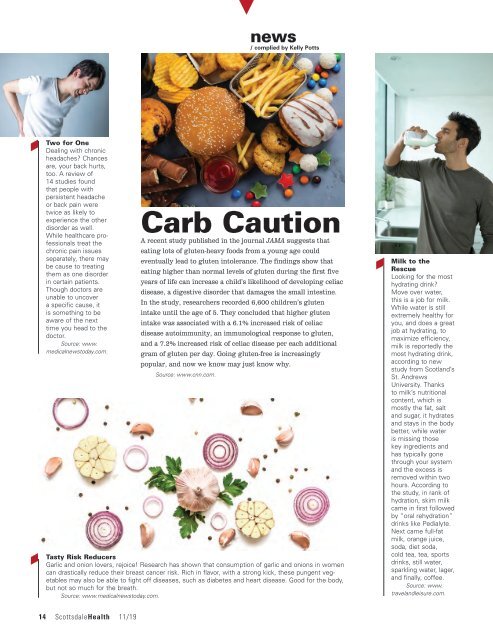Scottsdale Health November 2019
You also want an ePaper? Increase the reach of your titles
YUMPU automatically turns print PDFs into web optimized ePapers that Google loves.
news<br />
/ complied by Kelly Potts<br />
Two for One<br />
Dealing with chronic<br />
headaches? Chances<br />
are, your back hurts,<br />
too. A review of<br />
14 studies found<br />
that people with<br />
persistent headache<br />
or back pain were<br />
twice as likely to<br />
experience the other<br />
disorder as well.<br />
While healthcare professionals<br />
treat the<br />
chronic pain issues<br />
separately, there may<br />
be cause to treating<br />
them as one disorder<br />
in certain patients.<br />
Though doctors are<br />
unable to uncover<br />
a specific cause, it<br />
is something to be<br />
aware of the next<br />
time you head to the<br />
doctor.<br />
Source: www.<br />
medicalnewstoday.com.<br />
Carb Caution<br />
A recent study published in the journal JAMA suggests that<br />
eating lots of gluten-heavy foods from a young age could<br />
eventually lead to gluten intolerance. The findings show that<br />
eating higher than normal levels of gluten during the first five<br />
years of life can increase a child’s likelihood of developing celiac<br />
disease, a digestive disorder that damages the small intestine.<br />
In the study, researchers recorded 6,600 children’s gluten<br />
intake until the age of 5. They concluded that higher gluten<br />
intake was associated with a 6.1% increased risk of celiac<br />
disease autoimmunity, an immunological response to gluten,<br />
and a 7.2% increased risk of celiac disease per each additional<br />
gram of gluten per day. Going gluten-free is increasingly<br />
popular, and now we know may just know why.<br />
Source: www.cnn.com.<br />
Tasty Risk Reducers<br />
Garlic and onion lovers, rejoice! Research has shown that consumption of garlic and onions in women<br />
can drastically reduce their breast cancer risk. Rich in flavor, with a strong kick, these pungent vegetables<br />
may also be able to fight off diseases, such as diabetes and heart disease. Good for the body,<br />
but not so much for the breath.<br />
Source: www.medicalnewstoday.com.<br />
Milk to the<br />
Rescue<br />
Looking for the most<br />
hydrating drink?<br />
Move over water,<br />
this is a job for milk.<br />
While water is still<br />
extremely healthy for<br />
you, and does a great<br />
job at hydrating, to<br />
maximize efficiency,<br />
milk is reportedly the<br />
most hydrating drink,<br />
according to new<br />
study from Scotland’s<br />
St. Andrews<br />
University. Thanks<br />
to milk’s nutritional<br />
content, which is<br />
mostly the fat, salt<br />
and sugar, it hydrates<br />
and stays in the body<br />
better, while water<br />
is missing those<br />
key ingredients and<br />
has typically gone<br />
through your system<br />
and the excess is<br />
removed within two<br />
hours. According to<br />
the study, in rank of<br />
hydration, skim milk<br />
came in first followed<br />
by “oral rehydration”<br />
drinks like Pedialyte.<br />
Next came full-fat<br />
milk, orange juice,<br />
soda, diet soda,<br />
cold tea, tea, sports<br />
drinks, still water,<br />
sparkling water, lager,<br />
and finally, coffee.<br />
Source: www.<br />
travelandleisure.com.<br />
14 <strong>Scottsdale</strong><strong>Health</strong> 11/19

















